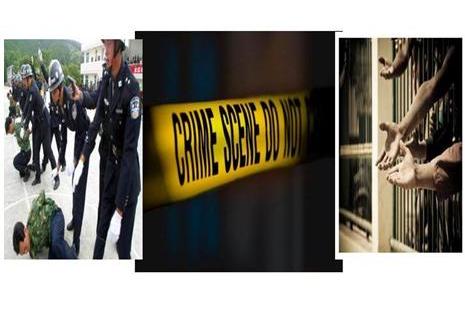
CRIME AS THE EFFECTS OF POVERTY
Crime varies over time and space. It's high in specific areas and low in others, most of the time those that are poor or rich. This has always led experts to study why and what happens in those places where there is a concentration of crime. It's unquestionable that crime ranks high among the effects of poverty, and those impoverished neighborhoods or entire cities show the same problems with uneducated labor nurturing more unemployment and crime, and then leading to chronic, long lasting poverty.
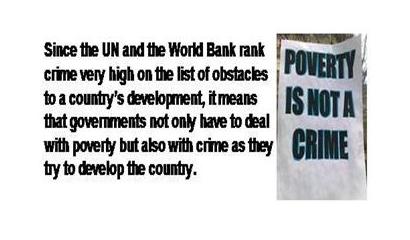
The presence of crime prevents businesses from thriving by increasing uncertainty and instability (at micro and macroeconomic levels) in any given market, be it national, regional, municipal or even neighborhood-al (okay the word doesn't exist, you got me).
And the same international institutions also accuse crime - though including corruption - of putting at risk Africa's and Latin America's chances of development nowadays. Entire continents. Crime then has this capacity to take an economy into a vicious cycle that causes unemployment and low growth. Poverty and crime combined together leave people with two choices: benefiting from criminally generated income or legal-but-extremely-rare one.
But most important of all, the unmistakable characteristic of poverty and crime is that they're both geographically concentrated in the same areas, which reveals the strong link between them.
The "racial divide": linking segregation, poverty and crime
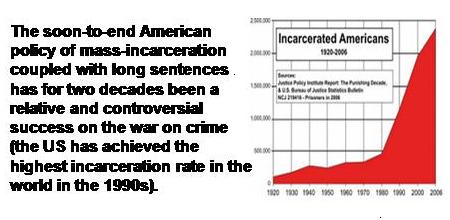
A recent book by Todd Clear (Imprisoning Communities, Oxford University Press 2007) offers new evidence that indeed over the years the get-tough-on-crime stance has actually contributed to fuel crime and second offenses. So in the long run the effect of imprisonment on crime is not much. In the end what do you expect prisoners to learn in prison? It's certainly not by (over)crowding up criminals in small cells that they'll learn about social norms or the virtues of universal love.
Lead poisoning: aggravating poverty and crime?
The relationship between lead poisoning and violence has long been established by medical studies and was then followed by social scientific ones to study the possibility of large-scale lead poisoning: lead levels in the air, soil, water and food; as it's been fairly high, especially a few decades ago because of lead-based paint and leaded gasoline (forbidden since the 70s in the US). And there was indeed a direct impact on property and violent crime revealed across thousands of cities, and the effect actually proves all the worse in poor areas.
The reason is that impoverished areas have had the least resources - as much in terms of health care education on the risks of lead poisoning as in terms of financial means and resources - to treat or prevent the disease.
Less money to fix the hazardous infrastructure such as old water pipes and wall paint (you need to repaint everything), protection from toxic dust during any renovation, basic health recommendations (things as simple as preventing your children from putting their hands in their mouths and washing your hands frequently), etc. And most of all, poor areas are often located nearby industrial ones, which are the richest you could find in terms of lead levels in the air, soil and water.
Inequalities: income and unemployment
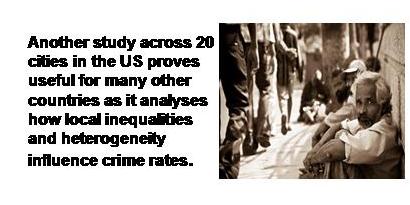
Since more and more countries face ever-mounting problems related to immigration, policymakers should be aware that inequality, even within one ethnic group, is a major factor for crime.
History has proven that there is in fact a direct link between poverty and crime. America, although full of good-hearted citizens, has yet to recognize the importance of balancing the economic makeup of its inner-city and urban areas with that of the money spent on imprisoning those who commit crimes.
The severity of poverty often goes hand in hand with the amount of crimes committed. Money is often reinvested from the open market to the black market to bring about high yet risky return in urban areas. Risks such as these are even higher when this activity is controlled by violent mob-type organizations and gangs, whose existences are structured around capitalizing on the poverty of others. Realistic and reachable role models are far and few between, if any exist at all, which causes the children of those who live in these areas to look up to more unsavory figures who are living the high life through low living.
Theories/Speculation
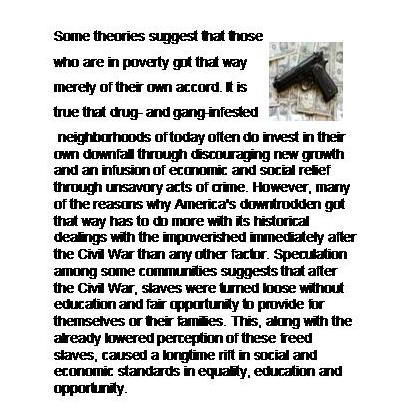
Misconceptions
Society on a whole has a general misconception of the link between poverty and crime. Although crime is often committed by those who are impoverished, all those who are poor do not commit crimes. Other misconceptions include the assumption that people of color are automatically more likely to commit crime because of the color of their skin rather than their surroundings and upbringing. Many of these misconceptions may lead to adverse effects of racism and bigotry in real-life meetings between those with and those without. Understanding and solving the root of the link between poverty and crime will inevitably cause citizens to take pride in their neighborhoods and become productive participants in the labor force. Time Frame
Obliterating poverty has been the goal of many politicians throughout history, but nothing of this magnitude will be solved overnight. Improved means of wealth distribution, better economic policies and a society-wide commitment to solving the problem, eradicating poverty--and therefore some of the crime that goes with it-- may take decades or longer, but it is certainly a worthy and noble cause.

